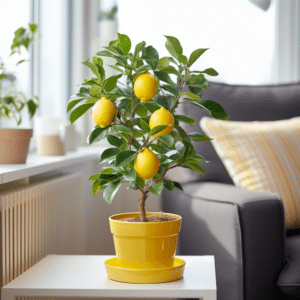Indoor lemon trees are a delightful addition to any home, offering not only a splash of vibrant color but also the opportunity to grow your own fresh citrus. These compact trees are surprisingly easy to care for, provided you understand their basic needs. In this comprehensive guide, we will delve into everything you need to know about growing and maintaining a healthy indoor lemon tree.
The Benefits of an Indoor Lemon Tree

Before we delve into the specifics of care, it’s worth exploring why you might want to consider an indoor lemon tree. These trees offer a host of benefits that go beyond their aesthetic appeal.
Firstly, indoor lemon trees can improve air quality. Like all plants, they absorb carbon dioxide and release oxygen, contributing to a healthier indoor environment. Furthermore, they can help increase humidity in dry indoor spaces, which can be beneficial during the winter months when heating systems can cause the air to become dry.
Secondly, indoor lemon trees can bear fruit. While it may take a few years for the tree to mature and produce lemons, the wait is well worth it. There’s nothing quite like picking a fresh lemon from your own tree to use in your cooking or drinks.
Choosing the Right Indoor Lemon Tree
There are several varieties of lemon trees that are suitable for indoor cultivation. The key is to choose a dwarf variety, which will remain a manageable size for indoor spaces.
The Improved Meyer Lemon tree is a popular choice for indoor cultivation. This variety is known for its sweet, flavorful fruit and its resistance to common citrus diseases. It’s also a prolific fruit producer, often bearing lemons throughout the year.
Another good option is the Ponderosa Lemon tree. This variety produces large, juicy lemons and has a robust, bushy growth habit that can add a lush, tropical feel to your indoor space.
How to Care for Your Indoor Lemon Tree

Light Requirements
Indoor lemon trees require plenty of light to thrive. Ideally, they should receive at least 10 to 12 hours of sunlight each day. A south-facing window is often the best location. If you don’t have a suitable window, you can supplement natural light with a grow light.
Keep in mind that your tree may need to be rotated periodically to ensure all sides receive adequate light. This will help prevent the tree from becoming lopsided as it grows towards the light.
Watering and Feeding
Proper watering is crucial for the health of your indoor lemon tree. The soil should be kept consistently moist, but not waterlogged. Overwatering can lead to root rot, a serious condition that can kill your tree. A good rule of thumb is to water when the top inch of soil feels dry to the touch.
Feeding your tree is also important. Use a slow-release citrus fertilizer, following the package instructions for application rates and frequency. This will provide your tree with the nutrients it needs to grow and produce fruit.
Pruning and Repotting
Pruning your indoor lemon tree will help maintain its shape and size, making it more manageable for indoor spaces. It can also encourage more fruit production. Prune in early spring, removing any dead or diseased branches and thinning out crowded areas to improve air circulation.
Repotting your tree every few years can also be beneficial. As the tree grows, it may become root-bound in its current pot. Choose a pot that is one size larger than the current one and use a well-draining potting mix designed for citrus trees.
Common Problems and Solutions

Like all plants, indoor lemon trees can encounter a few problems. However, with a little knowledge and care, these issues can be easily managed.
Pests
Common pests that can affect indoor lemon trees include aphids, spider mites, and scale insects. These pests can cause yellowing leaves, stunted growth, and reduced fruit production. Regularly inspect your tree for signs of pests and treat with an insecticidal soap or neem oil if needed.
Diseases
Citrus trees can be susceptible to several diseases, including citrus canker and root rot. Regular pruning can help prevent these diseases by improving air circulation. If your tree does become diseased, it may need to be treated with a fungicide or, in severe cases, removed to prevent the disease from spreading.
Conclusion
With a little care and attention, an indoor lemon tree can be a rewarding addition to your home. Not only do these trees add a touch of tropical beauty, but they can also provide you with a steady supply of fresh, homegrown lemons. Whether you’re a seasoned gardener or a complete beginner, growing an indoor lemon tree is a project that’s well worth considering.